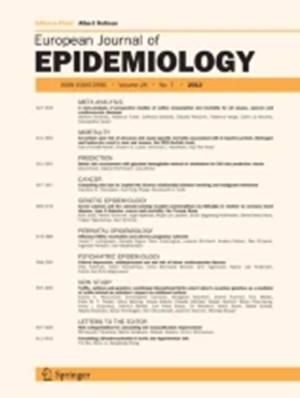Heavy prenatal alcohol exposure and healthcare use during childhood and adolescence: a Danish nationwide cohort study 1997-2022.
IF 5.9
1区 医学
Q1 PUBLIC, ENVIRONMENTAL & OCCUPATIONAL HEALTH
引用次数: 0
Abstract
Children with heavy prenatal alcohol exposure may experience increased healthcare needs and access barriers. We aimed to quantify their healthcare utilisation patterns compared to all other Danish children in this nationwide cohort study of children born 1997-2020, followed until Dec 31, 2022. Data was derived from eight national registers. Heavy prenatal alcohol exposure was defined by hospital contacts with 100% alcohol-attributable diagnoses given to mother or child, redeemed prescriptions for drugs to treat alcohol dependence, or enrollment into treatment clinics, one year before or during pregnancy. We estimated age- and sex-specific rates and incidence rate ratios (IRRs) for use of somatic and psychiatric hospitals, and use of general practice (GP), and risk ratio (RR) for participation in the GP-based preventive child health programme. Of 1,457,962 children followed for 17,778,705 person-years, 5898 (0.4%) were heavily prenatal alcohol exposed. Exposed children had higher use of GP and hospitals compared to reference children, particularly notable for psychiatric hospital contacts with IRR for respectively ages 0-5, 6-11 and 12-18 years of 3.55 (2.98-4.24), 2.68 (2.41-2.98), and 2.19 (1.95-2.46); and for planned outpatient contacts 2.01 (1.92-2.10), 1.29 (1.21-1.37), and 1.20 (1.12-1.28). Despite higher healthcare use, participation in the preventive child health programme had a RR of 0.69 (95% CI 0.67-0.72) for exposed compared to reference children. The higher use of hospitals and GP, but lower participation in the child health programme underscores the long-term consequences and societal burden of heavy prenatal alcohol exposure, and leaves a need for awareness and adequate support to ensure health equity.大量产前酒精暴露和儿童和青少年期间的医疗保健使用:1997-2022年丹麦全国队列研究
产前大量接触酒精的儿童可能面临更多的保健需求和获取障碍。我们旨在量化他们的医疗保健利用模式,并将其与1997-2020年出生的所有其他丹麦儿童进行全国队列研究,随访至2022年12月31日。数据来自八个国家登记册。重度产前酒精暴露的定义是,在怀孕前或怀孕期间,与医院接触的母亲或孩子的诊断结果100%与酒精有关,获得治疗酒精依赖的药物处方,或进入治疗诊所。我们估计了年龄和性别特定的比率和使用躯体和精神病院的发病率比(IRRs),以及使用全科医生(GP),以及参与以全科医生为基础的预防性儿童保健计划的风险比(RR)。在17778705人年随访的1457962名儿童中,5898名(0.4%)产前重度酒精暴露。与对照儿童相比,暴露儿童使用全科医生和医院的比例更高,特别是在0-5岁、6-11岁和12-18岁的精神病院接触的IRR分别为3.55(2.98-4.24)、2.68(2.41-2.98)和2.19 (1.95-2.46);计划门诊接触为2.01(1.92-2.10)、1.29(1.21-1.37)和1.20(1.12-1.28)。尽管医疗保健使用率较高,但与对照儿童相比,暴露儿童参与预防性儿童保健计划的相对危险度为0.69 (95% CI 0.67-0.72)。医院和全科医生的使用率较高,但儿童保健方案的参与率较低,这突出了产前大量饮酒的长期后果和社会负担,需要提高认识并提供足够的支持,以确保保健公平。
本文章由计算机程序翻译,如有差异,请以英文原文为准。
求助全文
约1分钟内获得全文
求助全文
来源期刊

European Journal of Epidemiology
医学-公共卫生、环境卫生与职业卫生
CiteScore
21.40
自引率
1.50%
发文量
109
审稿时长
6-12 weeks
期刊介绍:
The European Journal of Epidemiology, established in 1985, is a peer-reviewed publication that provides a platform for discussions on epidemiology in its broadest sense. It covers various aspects of epidemiologic research and statistical methods. The journal facilitates communication between researchers, educators, and practitioners in epidemiology, including those in clinical and community medicine. Contributions from diverse fields such as public health, preventive medicine, clinical medicine, health economics, and computational biology and data science, in relation to health and disease, are encouraged. While accepting submissions from all over the world, the journal particularly emphasizes European topics relevant to epidemiology. The published articles consist of empirical research findings, developments in methodology, and opinion pieces.
 求助内容:
求助内容: 应助结果提醒方式:
应助结果提醒方式:


